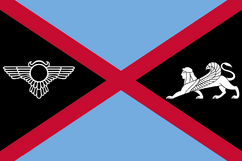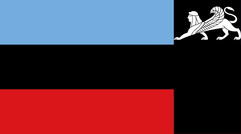Flags of Domlandia: Difference between revisions
No edit summary |
|||
| Line 2: | Line 2: | ||
== Sultanate of Domlandia (1857/8-1874) == | == Sultanate of Domlandia (1857/8-1874) == | ||
[[File:Domlandian Monarchy.png|thumb|''Reconstructed flag of the Domlandian Sultanate. The symbols are intentionally misaligned, as this was noted by a Nova-País tourist in 1869''| | [[File:Domlandian Monarchy.png|thumb|''Reconstructed flag of the Domlandian Sultanate. The symbols are intentionally misaligned, as this was noted by a Nova-País tourist in 1869''|242x242px]] | ||
The last time an independent Domlandian monarchy ruled the nation was also during the rise of Biggonian nationalism in the mid to late 19th century. Under the ----- dynasty, the Sultanate attempted to formalise and creating a long-lasting system, which they did through creating a flag. Although few photos exist and there are no surviving instances of the Domlandian flag during this period; vexiologists have tried their best to reconstruct the Domlandian Sultanate's flag based on as much information as possible. The Domlandian Sultanate was destroyed during the invasion of Domlandia by the Biggonian Confederation in 1874, and was reformed as the Viceroyalty of Domlandia the following year. | The last time an independent Domlandian monarchy ruled the nation was also during the rise of Biggonian nationalism in the mid to late 19th century. Under the ----- dynasty, the Sultanate attempted to formalise and creating a long-lasting system, which they did through creating a flag. Although few photos exist and there are no surviving instances of the Domlandian flag during this period; vexiologists have tried their best to reconstruct the Domlandian Sultanate's flag based on as much information as possible. The Domlandian Sultanate was destroyed during the invasion of Domlandia by the Biggonian Confederation in 1874, and was reformed as the Viceroyalty of Domlandia the following year. | ||
| Line 15: | Line 15: | ||
== First Domlandian Republic (1946/8-1997) == | == First Domlandian Republic (1946/8-1997) == | ||
The First Domlandian Repubilc was declared by rebels who had already seized much of the Domlandian countryside and several urban centres, including Musainon, in 1946. Although it would take until 1948 for the fledgling republic to be recognised by the Biggonian Empire, and until 1951 for them to fully restore order, they were able to create their own flag. The Domlandian Republic's flag uses almost identical colours to the Sultanate, however the winged beetle as a symbol of the ----- dynasty was removed to represent the modern Republic. Isil was included, both as a symbol of Domlandia but partially to symbolise an attempt to retake Domlandian culture after its abuse by Biggonian occupiers. | [[File:Domlandian Republic.png|thumb|241x241px|''The flag of the Domlandian Republic'']] | ||
The First Domlandian Repubilc was declared by rebels who had already seized much of the Domlandian countryside and several urban centres, including Musainon, in 1946. Although it would take until 1948 for the fledgling republic to be recognised by the Biggonian Empire, and until 1951 for them to fully restore order, they were able to create their own flag. The Domlandian Republic's flag uses almost identical colours to the Sultanate, however the winged beetle as a symbol of the ----- dynasty was removed to represent the modern Republic. Isil was included, both as a symbol of Domlandia but partially to symbolise an attempt to retake Domlandian culture after its abuse by Biggonian occupiers. As the first modern iteration of an independent Domlandia, the First Domlandian Republic's flag was frequently seen abroad in groups like the INTC, as well as at international summits. Athletes competed under the Domlandian flag at the Junic Games, football world cup, and other sporting competitions. Many old textbooks about the flags of the world still contain the Domlandian Republic's flag. Some early test-builds fof emojis from before 1997 even contain the Domlandian Republic's flag, although few of these were published. | |||
The Domlandian Republic's flag ceased to represent any internationally recognsied country after 1997 and the annexation of Domlandia into the Biggonian Empire; however it was used by the Domlandian National Front up until 2023 when it was assimilated into the Domlandian Unity Front. The Domlandian National Front had been founded by the former Domlandian Prime Minister with the support of the Domlandian National Army, and as such believed they were the legitimate continuation of the former Domlandian Republic. | The Domlandian Republic's flag ceased to represent any internationally recognsied country after 1997 and the annexation of Domlandia into the Biggonian Empire; however it was used by the Domlandian National Front up until 2023 when it was assimilated into the Domlandian Unity Front. The Domlandian National Front had been founded by the former Domlandian Prime Minister with the support of the Domlandian National Army, and as such believed they were the legitimate continuation of the former Domlandian Republic. | ||
Revision as of 10:22, 17 July 2024
It is difficult to get an understanding of what Domlandian flags were prior to the late 19th century, due to both poor record keeping on the part of historians and deliberate destruction of old artifacts by the Biggonian SIS during both period of occupation in order to destroy a national identity. However, it is understood that over history numerous flags were used to represent the various Domlandian polities. The few times Domlandia was unified, it would only be for a single generation under a warlord-esque figure and therefore their flags were not reused by successors. One of the few sources surrounding flags used by pre-modern Domlandians was that of accounts of the Biggonian Kingdom war, where a unified Domlandia fought against a coalition of Biggonian Kingdoms. Artists illustrations and eyewitness accounts state that the Domlandian army would tend to carry local banners, carrying words, family symbols, or various gods and spirits which represented the individual village or noble family the troops belonged to. Therefore it can be concluded that little in the way of a Domlandian Flag existed prior the mid 19th century.
Sultanate of Domlandia (1857/8-1874)
The last time an independent Domlandian monarchy ruled the nation was also during the rise of Biggonian nationalism in the mid to late 19th century. Under the ----- dynasty, the Sultanate attempted to formalise and creating a long-lasting system, which they did through creating a flag. Although few photos exist and there are no surviving instances of the Domlandian flag during this period; vexiologists have tried their best to reconstruct the Domlandian Sultanate's flag based on as much information as possible. The Domlandian Sultanate was destroyed during the invasion of Domlandia by the Biggonian Confederation in 1874, and was reformed as the Viceroyalty of Domlandia the following year.
Many design motifs, especially the colours on the flag, are repeated in later iterations of the Domlandian nation. Importantly, the goddess Isil is repeated in all later iterations of an independent Domlandia. Although Isil is normally seen simply as the goddess of media, culture, and sport, she was first featured in the Sultanate's flag to simply symbolise Musainon, the capital of Domlandia and of which Isil was the patron goddess. However, in later iterations Isil as a whole came to symbolise Domlandia.
Viceroyalty of Domlandia (1875-1948)
The Viceroyalty of Domlandia was established after the conquest and disestablishment of the Domlandian Sultanate in 1875. The Viceroy would be elected by the Biggonian Imperial Diet to serve for a five-year term. Due to the Biggonian Viceroys in Domlandia lacking their own noble roots, the flag of the Viceroyalty was wholly designed by the new adminastration. It took no inspiration from old Domlandia, being completely designed to eradicate any semblence of old Domlandia and instead reflect Biggonian occupation.
Although the Viceroyalty of Domlandia was almost wholly destroyed by 1946, as isolated Imperial army units fought for survival across the province; the position of Viceroy was only formally abolished in 1948 and the Vicroyalty with it thanks to the Biggonian Empire signing the Treaty of Musainon which recognised Domlandian independence.
First Domlandian Republic (1946/8-1997)
The First Domlandian Repubilc was declared by rebels who had already seized much of the Domlandian countryside and several urban centres, including Musainon, in 1946. Although it would take until 1948 for the fledgling republic to be recognised by the Biggonian Empire, and until 1951 for them to fully restore order, they were able to create their own flag. The Domlandian Republic's flag uses almost identical colours to the Sultanate, however the winged beetle as a symbol of the ----- dynasty was removed to represent the modern Republic. Isil was included, both as a symbol of Domlandia but partially to symbolise an attempt to retake Domlandian culture after its abuse by Biggonian occupiers. As the first modern iteration of an independent Domlandia, the First Domlandian Republic's flag was frequently seen abroad in groups like the INTC, as well as at international summits. Athletes competed under the Domlandian flag at the Junic Games, football world cup, and other sporting competitions. Many old textbooks about the flags of the world still contain the Domlandian Republic's flag. Some early test-builds fof emojis from before 1997 even contain the Domlandian Republic's flag, although few of these were published.
The Domlandian Republic's flag ceased to represent any internationally recognsied country after 1997 and the annexation of Domlandia into the Biggonian Empire; however it was used by the Domlandian National Front up until 2023 when it was assimilated into the Domlandian Unity Front. The Domlandian National Front had been founded by the former Domlandian Prime Minister with the support of the Domlandian National Army, and as such believed they were the legitimate continuation of the former Domlandian Republic.

